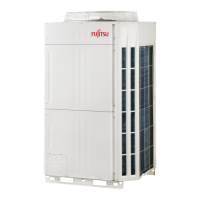
Do you have a question about the Fujitsu AirStage AJYA72GALH and is the answer not in the manual?
Safety guidelines for using R410A refrigerant and its specific requirements.
Lists specialized tools required for R410A refrigerant handling and installation.
Details included accessories and possible unit combinations for the system.
Lists optional components available for R410A refrigerant systems.
Guidelines for choosing a suitable location for the outdoor unit, considering safety and performance.
Instructions on how to properly manage condensate drainage from the outdoor unit.
Specifies the required clearances and dimensions for installing the outdoor unit.
Specifies clearances for units near walls, considering height and obstructions for proper ventilation.
Guidelines for installing units with obstacles above, including high static pressure mode settings.
Procedures and precautions for safely transporting the outdoor unit to the installation site.
Step-by-step instructions for physically mounting the outdoor unit, including anchor bolt placement.
Explains how to connect multiple outdoor units and considerations for system capacity.
Details on selecting appropriate pipe sizes and materials for R410A refrigerant systems.
Methods for protecting refrigerant pipes from moisture, dust, and damage during installation.
Instructions and precautions for brazing refrigerant pipes, emphasizing nitrogen gas use.
Guidance on connecting refrigerant pipes to indoor units and separation tubes.
Covers methods for connecting pipes, including knockout hole usage and pinch pipe removal.
Guidelines for connecting multiple outdoor units and indoor units in a system.
Essential safety warnings and guidelines for performing electrical wiring work to prevent hazards.
Illustrates wiring diagrams and step-by-step procedures for connecting system components.
Guidance on opening and using knockout holes for wiring entry and exit to protect cables.
Criteria for selecting appropriate power supply cables and circuit breakers for the unit based on capacity.
Details on transmission line types, sizes, and connection rules for system communication.
Identifies terminal locations and functions for external control and status monitoring.
Introduces the PC board switches used for various unit configuration settings.
Details on configuring DIP switches for unit addressing, slave count, and system configuration.
Instructions for setting terminal resistors in network segments to ensure proper communication system integrity.
How to set the refrigerant circuit address using the rotary switch for master unit configuration.
Describes how to use push buttons to configure operational settings like start-up timing, fan modes, and energy saving.
Procedures for setting addresses for signal amplifiers, both manually and automatically.
Procedures for setting addresses for indoor units, including manual and automatic methods.
Procedures for setting addresses for RB units, including manual and automatic methods.
Covers advanced piping tasks including sealing tests and vacuum processes.
Steps for performing sealing tests and vacuuming the system to ensure leak-free operation.
Procedures for calculating and adding refrigerant, including checks for total system capacity.
Guidelines for applying insulation material to refrigerant pipes to prevent condensation.
Instructions for performing pre-test checks, test operations, and final checklists for system verification.
Explains LED codes indicating normal operation, errors, and system status.
